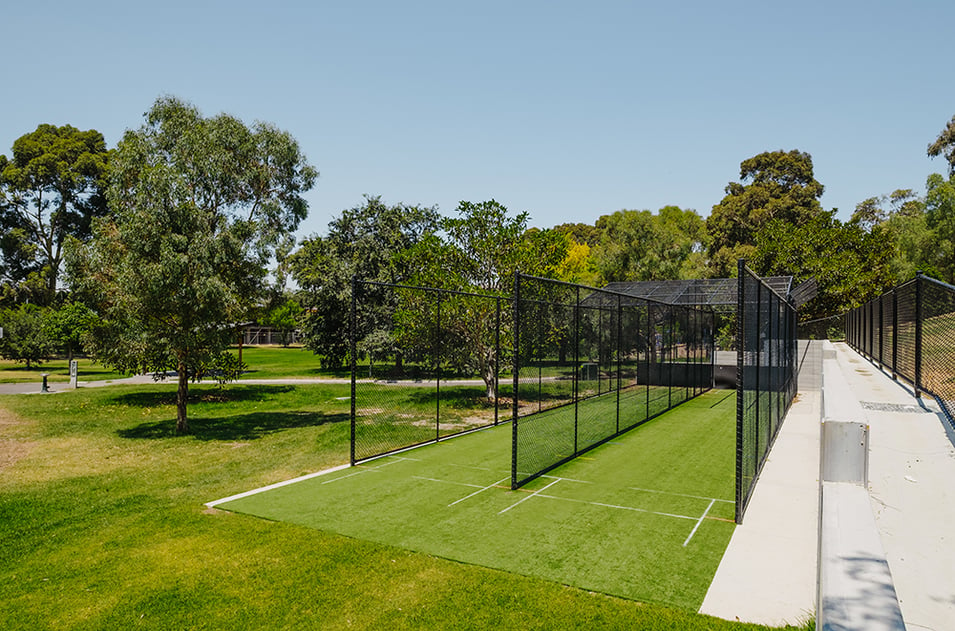A brief overview of cricket enclosures
Most cricket ovals also have some type of batting practice area to allow the clubs players to get the necessary training without having to utilise the centre wicket/s. They are a vital part of a cricket clubs’ infrastructure but are a commonly misunderstood element when it comes to design and construction.
There are different types of enclosure, but they can be broadly grouped into two main categories:
- Natural turf or synthetic surface,
- Solid chain mesh or retractable soft netting walls/roof.
What are the characteristics of natural turf enclosures?
Natural turf enclosures mostly consist of some structure with a chain mesh outer fence and soft netting internal dividers and roof. They must be flexible in their ability to change the position of the batting lane as the practice wickets use rotated throughout the season. They are bespoke items that require specialist design of both the wicket block and the structural elements that support the netting. They also require ongoing specialist maintenance to ensure the quality of the playing surface matches that of the centre wicket block. They are usually the most expensive solution among the available options.
What are the characteristics of synthetic turf enclosures?
Synthetic turf enclosures can be (but are not always) a lot less complex than turf ones. For this reason, they are also cheaper, which often makes them the go-to option for most cricket clubs. The synthetic turf turns them into a highly durable and all-weather option. Also, if designed as such, they can become highly adaptable to multiple different uses.

A synthetic turf cricket enclosure at the Sir Robert Menzies Reserve
What are the synthetic turf cricket enclosures classifications?
SPORTENG classifies our synthetic turf enclosures into one of three categories – AS1725.4 compliant, Non AS 1725.4 compliant and a MUGA (Multi-Use Games Area). There are some things that must be considered when designing these enclosures.
-
AS1725.4 compliant classification ($):
These enclosures are designed following the standards in the Australian Standard 1725.4 – Chain Link Fencing – Cricket Enclosures.
The standard outlines the following elements:
- Post sizes
- Rail sizes
- Footing sizes
- Chainmesh sizes
- Post and rail spacing
This is the cheapest option available as there is no structural engineering and all parts are available off the shelf.
-
Non AS1725.4 compliant classification ($$ - $$$):
It refers to any cricket specific enclosure that does not follow the Australian standard. This can be a difference in:
- Roof height
- Roof pitch direction
- Lane width
- Lane length
- Roof material (soft netting roof)
Additional cost can be expected regarding structural engineering and potential for specialist parts are usually being required.
The important thing to know is that any of these changes make it non-compliant to the Australian Standard. Therefore, a structural engineer should be engaged to ensure it is sufficiently sound to take the loads imparted on the structure due to use and environmental factors.
-
MUGA classification ($$$$):
This solution usually designates a completely bespoke design, consisting of chain mesh outer wall, a large net support structure, a soft net roof and movable internal divider nets.
It requires structural engineering of all members and footings as well as specialists and fabricated parts. There is also an exponential relationship between enclosure width and structural requirement. Therefore, the cost is significantly more to construct than an AS 1725.4 compliant enclosure.
Cricket enclosures need to be installed on solid, reliable surfaces. To do so, ideal conditions need to be created to obtain premium cricket wicket soils. We've shared some insights on cricket wicket soils ideal characteristics and how to maintain it here.
To summarise, there are many different types of practice enclosure available to councils and cricket clubs. The type that is constructed is usually driven by the budget. As such, it is important that all stakeholders understand the differences between design options and the implications of pursuing a specific design. A seemingly simple change can result in a large cost increase to the project if all factors are not properly considered.
SPORTENG can provide guidance and top-notch design for your future cricket net enclosure.
Contact us now for more information.

